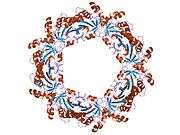Peroxiredoxin 2
| View/Edit Human | View/Edit Mouse |
Peroxiredoxin-2 is a protein that in humans is encoded by the PRDX2 gene.[3][4]
This gene encodes a member of the peroxiredoxin family of antioxidant enzymes, which reduce hydrogen peroxide and alkyl hydroperoxides. The encoded protein may play an antioxidant protective role in cells, and may contribute to the antiviral activity of CD8(+) T-cells. This protein may have a proliferative effect and play a role in cancer development or progression. The crystal structure of this protein has been resolved to 0.27 nm (= 2.7 angstroms). Transcript variants encoding distinct isoforms have been identified for this gene.[4]
References
- ↑ "Human PubMed Reference:".
- ↑ "Mouse PubMed Reference:".
- ↑ Pahl P, Berger R, Hart I, Chae HZ, Rhee SG, Patterson D (Aug 1995). "Localization of TDPX1, a human homologue of the yeast thioredoxin-dependent peroxide reductase gene (TPX), to chromosome 13q12". Genomics. 26 (3): 602–6. doi:10.1016/0888-7543(95)80183-M. PMID 7607688.
- 1 2 "Entrez Gene: PRDX2 peroxiredoxin 2".
Further reading
- Yao Y, Taylor M, Davey F, RenY, Aiton J , Coote P, Chen X, Yan SD & Gunn-Moore FJ. (2007). "Interaction of Amyloid binding Alcohol Dehydrogenase/Aβ mediates up-regulation of peroxiredoxin II in the brains of Alzheimer's disease patients and a transgenic Alzheimer's disease mouse model.". Molecular and Cellular Neuroscience. 35 (2): 377–82. doi:10.1016/j.mcn.2007.03.013. PMID 17490890.
- Rasmussen HH, van Damme J, Puype M, et al. (1993). "Microsequences of 145 proteins recorded in the two-dimensional gel protein database of normal human epidermal keratinocytes.". Electrophoresis. 13 (12): 960–9. doi:10.1002/elps.11501301199. PMID 1286667.
- Shau H, Butterfield LH, Chiu R, Kim A (1994). "Cloning and sequence analysis of candidate human natural killer-enhancing factor genes.". Immunogenetics. 40 (2): 129–34. doi:10.1007/BF00188176. PMID 8026862.
- Chae HZ, Robison K, Poole LB, et al. (1994). "Cloning and sequencing of thiol-specific antioxidant from mammalian brain: alkyl hydroperoxide reductase and thiol-specific antioxidant define a large family of antioxidant enzymes.". Proc. Natl. Acad. Sci. U.S.A. 91 (15): 7017–21. doi:10.1073/pnas.91.15.7017. PMC 44329
 . PMID 8041738.
. PMID 8041738. - Lim YS, Cha MK, Yun CH, et al. (1994). "Purification and characterization of thiol-specific antioxidant protein from human red blood cell: a new type of antioxidant protein.". Biochem. Biophys. Res. Commun. 199 (1): 199–206. doi:10.1006/bbrc.1994.1214. PMID 8123012.
- Lim YS, Cha MK, Kim HK, Kim IH (1994). "The thiol-specific antioxidant protein from human brain: gene cloning and analysis of conserved cysteine regions.". Gene. 140 (2): 279–84. doi:10.1016/0378-1119(94)90558-4. PMID 8144038.
- Golaz O, Hughes GJ, Frutiger S, et al. (1994). "Plasma and red blood cell protein maps: update 1993.". Electrophoresis. 14 (11): 1223–31. doi:10.1002/elps.11501401183. PMID 8313871.
- Cha MK, Kim IH (1996). "Glutathione-linked thiol peroxidase activity of human serum albumin: a possible antioxidant role of serum albumin in blood plasma.". Biochem. Biophys. Res. Commun. 222 (2): 619–25. doi:10.1006/bbrc.1996.0793. PMID 8670254.
- Ji H, Reid GE, Moritz RL, et al. (1997). "A two-dimensional gel database of human colon carcinoma proteins.". Electrophoresis. 18 (3-4): 605–13. doi:10.1002/elps.1150180344. PMID 9150948.
- Wang ZM, Liu C, Dziarski R (2000). "Chemokines are the main proinflammatory mediators in human monocytes activated by Staphylococcus aureus, peptidoglycan, and endotoxin.". J. Biol. Chem. 275 (27): 20260–7. doi:10.1074/jbc.M909168199. PMID 10751418.
- Cha MK, Yun CH, Kim IH (2000). "Interaction of human thiol-specific antioxidant protein 1 with erythrocyte plasma membrane.". Biochemistry. 39 (23): 6944–50. doi:10.1021/bi000034j. PMID 10841776.
- Schröder E, Littlechild JA, Lebedev AA, et al. (2000). "Crystal structure of decameric 2-Cys peroxiredoxin from human erythrocytes at 1.7 A resolution.". Structure. 8 (6): 605–15. doi:10.1016/S0969-2126(00)00147-7. PMID 10873855.
- Harris JR, Schröder E, Isupov MN, et al. (2001). "Comparison of the decameric structure of peroxiredoxin-II by transmission electron microscopy and X-ray crystallography.". Biochim. Biophys. Acta. 1547 (2): 221–34. doi:10.1016/s0167-4838(01)00184-4. PMID 11410278.
- Noh DY, Ahn SJ, Lee RA, et al. (2001). "Overexpression of peroxiredoxin in human breast cancer.". Anticancer Res. 21 (3B): 2085–90. PMID 11497302.
- Kim SH, Fountoulakis M, Cairns N, Lubec G (2002). "Protein levels of human peroxiredoxin subtypes in brains of patients with Alzheimer's disease and Down syndrome.". J. Neural Transm. Suppl. (61): 223–35. doi:10.1007/978-3-7091-6262-0_18. PMID 11771746.
- Rabilloud T, Heller M, Gasnier F, et al. (2002). "Proteomics analysis of cellular response to oxidative stress. Evidence for in vivo overoxidation of peroxiredoxins at their active site.". J. Biol. Chem. 277 (22): 19396–401. doi:10.1074/jbc.M106585200. PMID 11904290.
- Anahory T, Dechaud H, Bennes R, et al. (2002). "Identification of new proteins in follicular fluid of mature human follicles.". Electrophoresis. 23 (7-8): 1197–202. doi:10.1002/1522-2683(200204)23:7/8<1197::AID-ELPS1197>3.0.CO;2-2. PMID 11981869.
- Shen C, Nathan C (2002). "Nonredundant antioxidant defense by multiple two-cysteine peroxiredoxins in human prostate cancer cells.". Mol. Med. 8 (2): 95–102. PMC 2039972
 . PMID 12080185.
. PMID 12080185. - Geiben-Lynn R, Kursar M, Brown NV, et al. (2003). "HIV-1 antiviral activity of recombinant natural killer cell enhancing factors, NKEF-A and NKEF-B, members of the peroxiredoxin family.". J. Biol. Chem. 278 (3): 1569–74. doi:10.1074/jbc.M209964200. PMID 12421812.
- Strausberg RL, Feingold EA, Grouse LH, et al. (2003). "Generation and initial analysis of more than 15,000 full-length human and mouse cDNA sequences.". Proc. Natl. Acad. Sci. U.S.A. 99 (26): 16899–903. doi:10.1073/pnas.242603899. PMC 139241
 . PMID 12477932.
. PMID 12477932.
This article is issued from Wikipedia - version of the 8/3/2016. The text is available under the Creative Commons Attribution/Share Alike but additional terms may apply for the media files.


